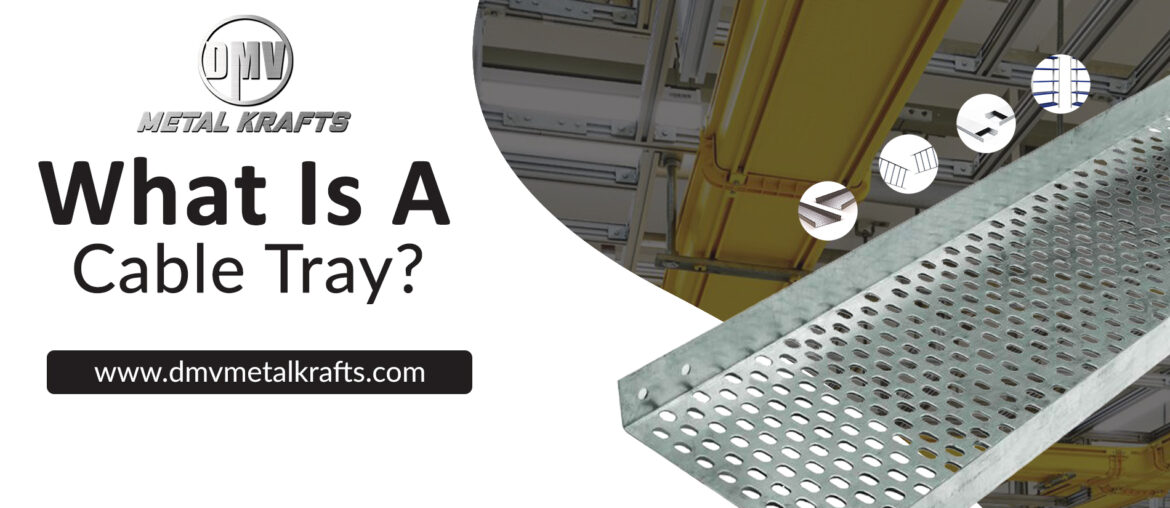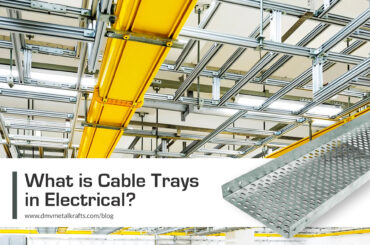Cable Tray is a light weight structural electrical support system that allows safe harnessing and transport of cables and electrical flexible conduits across open spans and gives protection against the overheating and fire build up problems .
There are under mentioned types of Cable Trays:
Cable trays are made of either CRCA Sheet, Galvanized Iron ( GI ), Steel, Aluminium or Fibre reinforced plastic (FRP) and are finished as Pre-Galvanized Iron, Powder Coated, Painted or Hot Dip Galvanized and are available in six basic types,
- Ladder Type Cable Tray
- Solid Bottom Cable Tray
- Trough Cable Tray.
- Channel Cable Tray
- Wire Mesh Cable Tray
- Single Rail Cable Tray.
Most predominantly used Cable Trays are Light Weight Structural Electrical Support System which are Hot Dip Galvanized ( HDG ), Pre-Galvanized, CRCA Sheet with Powder Coated finish or Painted Finish. The most preferred Cable Trays being practiced manufacturing and supply are Ladder Type, Perforated HDG Cable Trays.
Most of the commercial systems like Shopping Malls, Multistoried residential complex l as well as industrial sectors which include Industries, Hospitals, and Transportation Systems like Metro railways, Bus Stand, Railway Station, Airports use this method as an alternative to conduit system as it is safe and one can rely on it.
We at DMV Metal Krafts are committed to manufacture and supply customized needs of Cable Tray ( Perforated or Ladder) Type in HDG or Powder Coated Finish manufactured from high quality CRCA , HRC or GI Sheets
Design Specifications for Cable Trays :
“IS”code for cable tray?
IEC-61537 – This international standard specifies necessities and applicable tests for cable tray systems (such as; all metal cable trays including wire mesh cable tray and nonmetallic cable trays) for the desired support, fitment of cables and likely other electrical load equipment for electrical and desired communications systems management.
Maximum Cabling Sustenance in kg per meter is Cable laying area ( in sq. meter ) * 2800
What is the standard size of cable tray?
Thickness Available is : 1.2 mm , 1.6 mm, 2.0 mm, 2.5 mm, 3.0 mm. or as per customer and electrical load requirement
Standard Depths : 25, 40, 50, 75, 100mm or as per customer and electrical load requirement
Standard Lengths : 2500 mm – 3000 mm ( 2.5 mtrs.- 3.0 mtrs. ) or as per customer and electrical load requirement
Standard Height : 10 mm – 25 mm. or as per customer and electrical load requirement
Procedure for Calculating Area of Cable Tray :
Procedure for calculating Area of Cable Tray =300X100 = 30000 Sq.mm. Checking Width of Cable Tray. Calculate existing width of the Cable Tray ( perforated or ladder type ) as per Calculation expression shall be ; No. of Layer of Cable * No of Runs of Cable tray * existing Width of Cables. Thus ; width of Cable Tray as per Calculation comes out to be 1*1*493 comes out to be 493 mm.
How do I measure tray size?
For the Tray: Measure Length x Width x Height ( in mm. )
- Length, shall be measured the longest side of the tray from left to right.
- Width shall be measured from front to back.
- Height shall be measured from top to bottom of the tray.
How is bending radius of a cable tray being calculated ?
The minimum bend radius is 6 * Overall existing diameter of Cable.
What is rung spacing in cable tray?
The most prevalent rung intermittent distances for ladder type cable tray is 9 inches ( 228.6 mm. ) . This spacing is used to support almost all sizes of cables.
How far apart should cable supports be installed?
That cable must be preserved in place at intervals not to go beyond tolerance range of 1371.6 mm and within tolerance of 305-10 mm from every utility to load center or fitting.
How much weight can a cable tray hold?
Most of the Cable trays and rungs are designed to handle cable loads of approx.. 90-92 Kgs.
Other Important Facts of Cable Trays are :
- Does cable tray need to be earthed?
If the tray is used as a protective conductor then it must be earthed.
- Why cable tray needs to be perforated?
Cable Trays come in two variants where first is ladder type and second is perforated.
Generally technical parameters of both the Cable Trays are almost identical but it is very much inquisitive Why cable tray needs to be perforated?
Perforated cable trays have enough of holes on bottom to provide required ventilation and cable support and tying position for cable lines. It also helps in anti-corrosion, fire safety, moisture prevention because of the pre-galvanized, hot-dipped galvanized , powder coated, epoxy coated finish which results in required heat dispersion. Also, safe and smooth edge protects cable lines from scratch.
- Mention 3 most recommended procedure to support cable runs?
Normal cable-support systems incorporates perforated cable trays, ladder racks, enclosed cable, Light Weight Structural Electrical Support System clamps, rings, and suitable size fasteners. The support method chosen for project mostly depends on the size, quantity, and placement of the Light Weight Structural Electrical Support System.
- Is cable tray equivalent to be considered as a raceway?
Cable tray is classified as per NEC (NFPA 70 the National Electrical Code) mostly a pre-distinctive support system and not actually as a raceway. In common terminologies raceway completely encloses the cable inside of it.
- Differentiation as justified between cable tray and cable ladder.
Cable trays are predominantly used for low current rating cable support, in addition to other telecommunication, and flexible conduit processes. Cable Ladders used for higher current rating and distant cabling requiring more nos. of Cable supports.
Visit Us: Cable tray manufacturer


